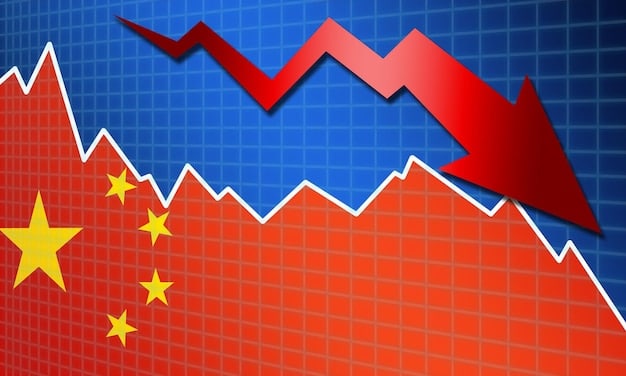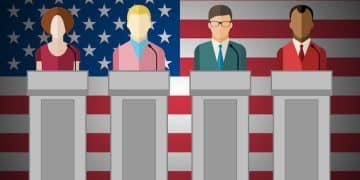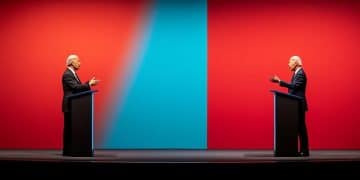Evaluating the President’s Trade Policies: Are They Working?

Evaluating the Impact: Are the President’s Policies Actually Reducing the Trade Deficit? A Data-Driven Analysis reveals a complex picture, suggesting that while some policies have shown initial promise, their overall effectiveness is still under debate and heavily influenced by global economic factors.
Have the President’s trade policies truly made a dent in the US trade deficit? This analysis dives deep into the data to evaluate the impact: are the President’s policies actually reducing the trade deficit? A data-driven analysis, we aim to provide clarity amidst the political rhetoric.
Understanding the US Trade Deficit: A Primer
The US trade deficit has been a topic of discussion for decades, representing the difference between the value of goods and services the country imports versus what it exports. Before evaluating the impact of presidential policies, it’s important to understand what the trade deficit is and why it matters.
What is the Trade Deficit?
The trade deficit occurs when a country imports more than it exports. In the United States, this has been a persistent issue, particularly with countries like China, Mexico, and Japan. The size of the trade deficit can fluctuate based on various factors, including economic growth, currency exchange rates, and trade agreements.
Why Does It Matter?
The trade deficit is often seen as an indicator of economic health. A large deficit can suggest that a country is overly reliant on foreign goods, which can lead to job losses in domestic industries. On the other hand, it can also indicate strong consumer demand and a robust economy capable of purchasing imported goods. The implications are complex and depend on the broader economic context.
- Economic Indicator: Reflects a nation’s import-export balance.
- Job Impact: Can affect domestic employment in manufacturing and other sectors.
- Currency Valuation: Influences the strength of a country’s currency.
- Political Implications: Often at the center of trade policy debates.
Understanding these basics is crucial for assessing the effectiveness of any policy aimed at reducing it. The trade deficit isn’t just a number; it reflects fundamental aspects of the US economy and its relationships with other countries.
A Look at the President’s Key Trade Policies
The current administration has implemented several trade policies aimed at reshaping the US trade balance. To evaluate the impact: are the President’s policies actually reducing the trade deficit? A data-driven analysis requires examining the specific measures put in place and their intended effects.
Tariffs on Imported Goods
One of the most notable policies has been the imposition of tariffs on imported goods, especially from China. These tariffs were intended to make foreign goods more expensive, encouraging consumers and businesses to buy American-made products. The logic was that increasing domestic demand and production would lower the trade deficit.
Renegotiation of Trade Agreements
Another key strategy has been the renegotiation of existing trade agreements, such as NAFTA (North American Free Trade Agreement), which was replaced by the USMCA (United States-Mexico-Canada Agreement). The goal was to secure more favorable terms for US businesses, increasing exports and reducing imports.
- Tariff Implementation: Focused primarily on goods from China, affecting various industries.
- USMCA: Aims to modernize trade rules within North America.
- Bilateral Deals: Pursuing individual trade agreements with countries outside major blocs.
These policies represent a significant shift in US trade strategy, moving towards a more protectionist approach. Whether they are effectively reducing the trade deficit, however, remains a question that requires a detailed examination of empirical data.

Analyzing the Data: Has the Trade Deficit Decreased?
To determine whether the President’s policies are working, we need to analyze the available trade data. Have imports decreased? Have exports increased? And more importantly, what is the overall trend of the trade deficit? Only hard numbers can help evaluate the impact: are the President’s policies actually reducing the trade deficit? A data-driven analysis.
Looking at Import and Export Trends
Official trade statistics from the US Census Bureau and the Bureau of Economic Analysis provide a detailed breakdown of imports and exports. By comparing data from before and after the implementation of the new trade policies, we can see if there have been any significant changes. Have tariffs led to a decrease in imports as intended? What sectors have been most affected?
The Overall Trade Deficit Figure
While looking at specific import and export trends is important, the ultimate measure is the overall trade deficit. Has it shrunk since the President’s policies were enacted? And if so, is this reduction sustainable? It’s crucial to consider factors beyond just the trade policies themselves, such as global economic conditions and currency fluctuations.
Analyzing these numbers provides a foundation for understanding the real-world effects of the President’s trade strategies, separating fact from political rhetoric.
External Factors Influencing the Trade Deficit
Trade policies are not the only factor at play when it comes to the trade deficit. Global economic conditions, currency exchange rates, and the demand for US goods abroad all play significant roles. To accurately evaluate the impact: are the President’s policies actually reducing the trade deficit? A data-driven analysis must account for these variables.
Global Economic Conditions
If the global economy is weak, demand for US exports may decline, increasing the trade deficit regardless of domestic policies. Similarly, a strong global economy may boost demand for US goods, helping to reduce the deficit. Understanding these international economic currents is crucial.
Currency Exchange Rates
The value of the US dollar relative to other currencies can significantly affect trade. A strong dollar makes US exports more expensive and imports cheaper, potentially widening the trade deficit. Conversely, a weaker dollar can make US goods more competitive on the global market.

Taking these external influences into account provides a more nuanced understanding of the true impact of trade policies on the US trade balance.
Expert Opinions and Economic Forecasts
Economists have differing views on the effectiveness of the President’s trade policies. Some argue that they are necessary to protect American industries and jobs, while others contend that they harm consumers and disrupt global supply chains. Consider different viewpoints to better evaluate the impact: are the President’s policies actually reducing the trade deficit? A data-driven analysis needs various expert views.
Views Supporting the Policies
Proponents of the policies argue that tariffs and renegotiated trade agreements create fairer trade practices, level the playing field for US businesses, and encourage domestic investment. They may point to specific industries that have benefited from the policies as evidence of their success.
Criticisms of the Policies
Critics argue that the policies raise costs for consumers, damage relationships with trading partners, and lead to retaliatory measures from other countries. They may cite data showing industries negatively affected by the policies, such as those relying on imported materials. Any objective analysis is well served by weighing the pros and cons from multiple viewpoints.
- Economic Impacts: Disagreements on whether the policies are boosting or hindering economic growth.
- International Relations: Differing views on the impact on trade relations and global stability.
- Long-Term Effects: Debates over the sustainability and potential consequences of the policies.
Considering these differing opinions adds depth to our understanding of the potential and actual effects of the President’s trade policies.
Sector-Specific Impacts: Winners and Losers
The impact of trade policies is not uniform across all sectors of the economy. Some industries may benefit, while others may suffer. To fully evaluate the impact: are the President’s policies actually reducing the trade deficit? A data-driven analysis demands a sector-by-sector viewpoint.
Manufacturing
The manufacturing sector has been a major focus of the President’s trade policies. Tariffs on imported steel and aluminum, for example, were intended to boost domestic steel production. However, these tariffs can also raise costs for manufacturers who rely on these materials.
Agriculture
The agricultural sector has been significantly affected by retaliatory tariffs from other countries. Farmers have faced reduced exports and lower prices, particularly for crops like soybeans and corn. Trade negotiations and agreements have become critical for this sector.
By analyzing the specific impacts on key sectors, we can better understand the overall effectiveness and consequences of the President’s trade policies.
| Key Point | Brief Description |
|---|---|
| 📉 Trade Deficit | Difference between imports and exports; indicator of economic health. |
| 💰 Tariffs | Taxes on imported goods, aimed at making domestic products competitive. |
| 🤝 Trade Agreements | Deals like USMCA aim to modernize trade rules for US businesses. |
| 🌍 Global Factors | Global economy and currency rates greatly affect trade. |
FAQ
A trade deficit occurs when a country imports more goods and services than it exports. The United States has had a persistent trade deficit for several decades.
Tariffs are taxes imposed on imported goods. They are typically used to make imported goods more expensive, encouraging consumers to buy domestic products, hopefully boosting the local economy.
The United States-Mexico-Canada Agreement (USMCA) is a trade agreement that replaced NAFTA. It aims to modernize trade rules and secure more favorable terms for US businesses.
A strong dollar makes US exports more expensive and imports cheaper, potentially widening the trade deficit. Conversely, a weak dollar can make US goods more competitive.
Critics argue that the policies raise costs for consumers, damage relationships with trading partners, and lead to retaliatory measures from other countries. Some sectors suffer from reduced exports.
Conclusion
In conclusion, evaluating the impact: are the President’s policies actually reducing the trade deficit? A data-driven analysis reveals no easy answers. While some sectors might show localized benefits, the overall picture is influenced by a complex web of factors, requiring ongoing examination and adaptation.





